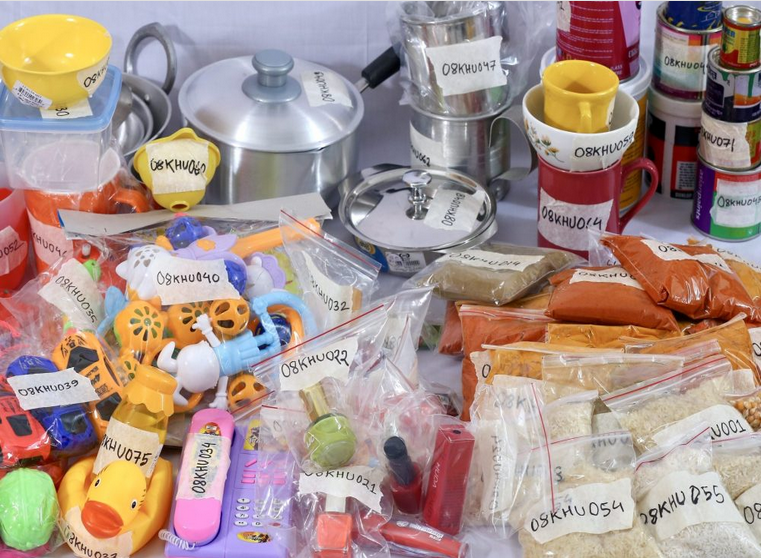
Laurie Udesky | November 1, 2024
Cookware and food for lead testing in Bangladesh. Credit: Pure Earth
Dr. Olufemi Adewole of Nigeria works to upend tuberculosis in hard-hit countries, including in Nigeria, which has the highest prevalence rate in all of Africa, killing 263 people daily.
A pulmonologist and professor of medicine at Obafemi Awolowo University in Ile-Ife, Nigeria, Adewole and his team are conducting a larger study to confirm their earlier findings that showed the effectiveness of adding a cholesterol-lowering medication, atorvastatin, to standard TB treatment. This follow-up study, which was funded by Open Philanthropy, is investigating the degree to which the combination of those medications helps reduce the spread of TB, accelerate a cure and prevent life-altering complications from the disease.
Adewole’s research team is just one of the recipients of a global health and wellbeing grant in 2023 from Open Philanthropy, a foundation established according to the principles of effective altruism — that is, tackling important neglected problems with evidence-based solutions that can save a high number of lives.
The effective altruism movement took a hit in public opinion when major proponent Sam Bankman-Fried’s cryptocurrency exchange failed and he was arrested for fraudulent schemes, but its less-publicized and more financially sound adherents in Silicon Valley have continued to operate on the giving philosophy that seeks to do the greatest good for the greatest number by tackling some of the most widespread and long-standing global public health problems.
San Francisco-based Open Philanthropy began life in 2011 as GiveWell Labs, a partnership between GiveWell — founded in 2007 by former hedge fund employees Elie Hassenfeld and Holden Karnofsky — and Good Ventures — founded in 2011 by former Facebook and Asana cofounder Dustin Moskowitz and his wife, former Wall Street Journal reporter Cari Tuna, as a way to give away their fortunes during their lifetime. GiveWell Labs rebranded as the Open Philanthropy Project in 2014. It became a separate entity as Open Philanthropy in 2017, but it still partners with Good Ventures, which provides funding for projects recommended by Open Philanthropy.
There’s considerable crossover. Tuna serves as Open Philanthropy’s president, developing the foundation’s strategies and work — which are the basis of most of Good Ventures’ grantmaking. She also serves on GiveWell’s board of directors, which continues to recommend projects to Open Philanthropy. (To learn more about Open Philanthropy’s history and giving strategies, see Michael Kavate’s 2024 article.)
Other grantees in the foundation’s global health and wellness portfolio, which totaled roughly $358 million in 2023, include what Open Philanthropy CEO and cofounder Alexander Berger describes as “low-hanging fruit.”
“If you look at where deaths from preventable causes, especially easily preventable causes, happen around the world, they’re happening very disproportionately in low- and middle-income countries, especially to young kids,” Berger said.
Lead in the paint
Another prime example is childhood exposure to lead, a neurotoxin still found in house paint in many lower-income countries but which has been banned as an ingredient in the U.S. since the 1970s. Lead exposure is an easily preventable problem that, left unchecked, can have irreversible neurological and behavioral effects on children and can cause heart disease and kidney damage in adults. It accounts for 1.5 million deaths for all ages globally each year.
One of the foundation’s newer grantees, the Lead Exposure Elimination Project (LEEP) started its work with the government of Malawi, where it tested paint, finding a high prevalence of lead. The government began cracking down on manufacturers and LEEP provided technical assistance to come up with affordable alternatives, explained Berger. LEEP was able to do this on a shoestring budget, explains Berger, and “they have already measured a reduction in the prevalence of lead in paint in these markets in Malawi,” he said.
Lead exposure, however, is rampant and grossly underfunded by philanthropists, according to Berger, who says that despite a global burden on par with tuberculosis and malaria, lead exposure elimination only gets about $15 million of philanthropic funding annually, just 1% of philanthropic funding provided to other neglected diseases.
This is precisely why Open Philanthropy launched a collaborative in September known as the Lead Exposure Action Fund (LEAF) along with the Alpha Epsilon Fund, the Bill and Melinda Gates Foundation, the Livelihood Impact Fund, the individual donor Lucy Southworth, the 10X Better Foundation and Good Ventures. The goal of the collaboration, according to a blog post written by Berger and Open Philanthropy’s Managing Director of Global Health and Well Being Emily Oehlsen is to kickstart progress on drastically reducing lead exposure by providing grants that support “measurement, mitigation and mainstreaming awareness of the problem.”
LEAF will commit $104 million in grants through 2027 and has already awarded $20 million. Grantees include The Center for Global Development to raise awareness about lead exposure within the global aid community; Pure Earth, which is working on making lead-acid battery recycling in Indonesia safer and is piloting an intervention for eliminating lead in cookware in India, and a collaboration between LEEP and researchers from Stanford and Mercer Universities who are working on a new way to assess lead levels in paint using portable XRF devices.
Related Inside Philanthropy Resources:
For Subscribers Only
- Global Health Grants
- State of American Philanthropy: Giving for Global Development
- State of American Philanthropy: Giving for Global Health
- Open Philanthropy Project
Lead in the food
Open Philanthropy’s interest in launching a broader effort to eliminate lead exposure and include other funders also stemmed from learning about the success of an earlier project, which checked off all the boxes of an issue that was important, tractable, neglected and would likely save a huge number of lives.
It involved an enterprising Stanford Ph.D. student, Jenna Forsyth and a team of researchers. Forsyth was determined to figure out why pregnant women in Bangladesh had soaring levels of lead in their blood. They weren’t the only ones. An estimate of somewhere between 23 and 46 million Bangladeshi children and teens have above-normal lead levels, according to a story about Forsyth’s work in Stanford Medicine Magazine.
“It turned out that lots of producers were adding lead to turmeric to make it more orange,” said Berger. “When you think about it, it’s like you’re just adding a neurotoxin to food! it’s just egregiously, really, really bad!”
The group, which had been testing spices for lead chromate, worked with the government and community members to build a public education campaign, prosecute and issue massive fines against scofflaws and blasted news about the prosecutions on television. Lead-laced spices accounted for 47% of the market share in 2019 and were completely eliminated in 2021, according to the Stanford Medicine Magazine story.
A global health portfolio
Lead elimination is part of the foundation’s Global Public Health Policy portfolio, which was launched in 2023 and also includes funding projects around public health campaigns to reduce alcohol consumption and preventing suicides by pesticides, a major problem in lower-income countries. Dr. Adewole and his team’s work on a new tuberculosis treatment is part of the foundation’s Global Health R&D. Another recent grant in Global Health R&D is a proof-of-concept trial to test whether bicarbonate of soda can reduce excess acidity in the blood during obstructed labor. The study will be led by Milton Musaba, Ph.D., at Busitema University in Uganda, as well as grantees at the Liverpool School of Tropical Medicine who are investigating whether two medications can work as antidotes to potentially deadly snake bites from snakes indigenous to Brazil and Ghana.
Along similar lines, Open Philanthropy’s Global Health and Well Being portfolio also supports scientific research that is novel and may not have garnered much support from other funders. One example is the foundation’s support for the work of Dr. Caitlin Howell of the University of Maine, who, with her team, discovered an inexpensive treatment to prevent the buildup of microbes on catheters, which are responsible for 20% of antimicrobial-resistant infections in hospitals.
All of this work comes back to what Berger says is at the core of how they select projects to pursue — the importance of the work, its tractability, and its status as a neglected area. “I think this work represents a sort of nascent but growing approach to high-impact philanthropy,” he says. And with the new funding collaborative on lead elimination, Berger has this message: “We’d definitely still love for other funders to join the fight against lead.”
Featured
Open Philanthropy Tackles the “Low-Hanging Fruit” in Public Health
Why an L.A. Inventor Gave Big to Launch a New Institute for Immunology
Remembering Dikembe Mutombo’s Global Philanthropy
Rockefeller Philanthropy Advisors Targets Lead Poisoning in the First of Its New “Big Bets”
Effective Altruism Needs a Gender Lens
Basic Data, Big Impact: Why Bloomberg’s Doubling Down on Tracking Global Births and Deaths
As Funding Dwindles, HIV and AIDS Remain as Much an Issue of Human Rights as of Health
How One Corporate Foundation Is Backing Maternal Health in the U.S. and Abroad
The WHO Foundation: Applying a “Start-up Mentality” to the Challenges of Global Health
Five Questions for Lim Seok Hui, CEO of the Philanthropy Asia Alliance
This New Global Funder Is All About Proximate, On-the-Ground Giving in Africa
Melinda French Gates Charts a Course for a “New Chapter.” Here Are Some Takeaways
Primary Sidebar
© 2024 - Inside Philanthropy

Comments